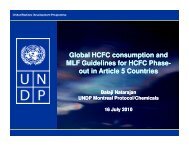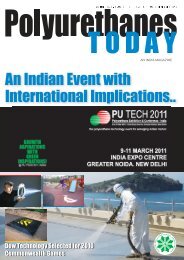Today - Polyurethane Association of India
Today - Polyurethane Association of India
Today - Polyurethane Association of India
You also want an ePaper? Increase the reach of your titles
YUMPU automatically turns print PDFs into web optimized ePapers that Google loves.
PU<br />
<strong>Today</strong><br />
Special Feature<br />
Polyols for improved HR slabstock foams<br />
K.Pickin, Corporate Business Development Manager, PCC SE<br />
High resilience (HR) foams have<br />
been utilized by the furnishings<br />
and mattress manufacturing industry<br />
for decades, with several polyurethane<br />
raw material suppliers <strong>of</strong>fering<br />
various solutions. The key property<br />
driving the adoption <strong>of</strong> these types <strong>of</strong><br />
flexible foams compared to standard<br />
foams is superior comfort at the<br />
same foam density. However, despite<br />
their long history, wide adoption<br />
and the expertise <strong>of</strong> competent<br />
foam manufacturers these HR foams<br />
types have not been fully optimized<br />
in terms <strong>of</strong>, for instance, yield and<br />
physical properties.<br />
Introduction<br />
In recent years there has been<br />
a significant increase in the<br />
manufacture <strong>of</strong> HR foams in Europe<br />
and, as expected, HR foams are now<br />
attracting the attention <strong>of</strong> many foam<br />
manufacturers in North America and<br />
Asia. Foam manufacturers in <strong>India</strong><br />
who are seeking to expand their<br />
foam range into superior comfort,<br />
high quality applications will find<br />
this development particularly<br />
interesting. In discussion with<br />
customers, especially in relation to<br />
future developments, PCC Rokita, a<br />
subsidiary <strong>of</strong> PCC SE headquartered<br />
in Duisburg, Germany, was made<br />
aware <strong>of</strong> the potential improvements<br />
that customers would like achieve<br />
with their HR foams.<br />
Thus improved HR foam technology<br />
became a key element in PCC<br />
Rokita’s emerging product expansion<br />
strategy.<br />
With this knowledge the research and<br />
40 p o l y u r e t h a n e s t o d a y<br />
development experts then set about<br />
developing new materials to enable<br />
the production <strong>of</strong> a range <strong>of</strong> superior<br />
HR foams featuring:<br />
• High comfort factor<br />
• Excellent durability<br />
• Class leading shape retention<br />
• Low odour<br />
• Wide density/hardness range<br />
• High yield<br />
Rokopol iPol – a case history<br />
In addition to the usual in-depth<br />
technical expertise and production<br />
know-how <strong>of</strong> different high resilience<br />
foam technologies, to improve the<br />
final foam and in turn mattress<br />
comfort properties, a study was<br />
undertaken to provide a genuine<br />
understanding <strong>of</strong> the needs <strong>of</strong> the<br />
whole supply change. In this case<br />
study, within the section <strong>of</strong> the supply<br />
chain involving polyols producer to<br />
end user there are essentially four<br />
key levels:<br />
1. Polyols producer<br />
2. Foam manufacturer<br />
3. Mattress manufacturer<br />
4. Retailer/End user<br />
Traditionally the supply chain<br />
is viewed as a flow <strong>of</strong> materials<br />
going, in this case, from polyols<br />
supplier to foam manufacturer<br />
to mattress producer to end user.<br />
Information usually follows in the<br />
same direction. However adding a<br />
flow <strong>of</strong> information in the reverse<br />
direction from end user to mattress<br />
producer to foam manufacturer to<br />
polyols producer gives an insight in<br />
to the needs throughout the supply<br />
chain. With this valuable information<br />
it is possible to target exactly what<br />
should be improved to meet the<br />
needs <strong>of</strong> each level in the chain<br />
and ultimately add value for every<br />
member <strong>of</strong> that chain.<br />
The supply chain needs analysis for<br />
Rokopol iPol is illustrated below:<br />
d e c e m b e r 2 0 1 1












